Chronic Pain
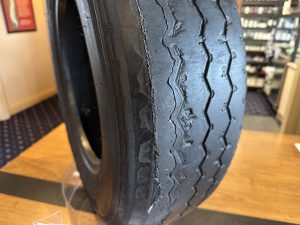
The Result of Poor Alignment
If phrases like “My back is out” or “I’ve got a crick in my neck” hit close to home, your spine might be sending you an SOS. Welcome to the world of spinal kinesiopathology – a fancy term for when your spine isn’t moving or aligning as it should.
Think of your spine as the freeway of your nervous system; when it’s out of alignment, your body can’t run smoothly. Whether it’s “text neck” from too much phone time or the aftermath of an awkward lift, poor alignment can ripple through your body, causing everything from headaches to fatigue.
Give your spine some TLC – it’s been holding you up for years!
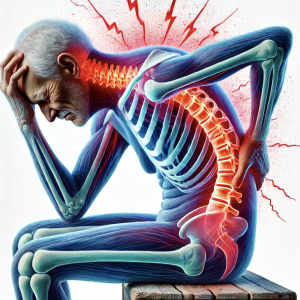
Adult Spinal Deformity
The Silent Menace
Adult Spinal Deformity Outweighs Other Chronic Conditions in Health Drama
When you think of health-related quality of life (HRQL) concerns, chronic conditions like arthritis, lung disease, diabetes, and congestive heart failure probably top your list.
But hold onto your lumbar support because Adult Spinal Deformity is here to steal the spotlight. We reveal how Adult Spinal Deformity is not just a Spinal issue – it is a Life issue.
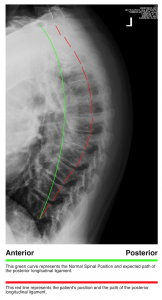
Fibromyalgia Related to Kyphotic Posture
Impaired Trunk Posture in Women With Fibromyalgia Pain
Increased Thoracic Kyphosis and Sagittal In-Balance ==> Increased Chronic Pain
A recent paper prepared out of the University of Valencia and Miguel Hernández University, Spain has been published through PubMed by Sempere-Rubio N and Aguilar-Rodríguez M et. al.
It investigates the relationship of mid back posture, thoracic kyphosis and forward head carriage in patients with Chronic Pain and Fibromyalgia Syndromes.

Determining the relationship between Cervical Lordosis and Neck Complaints
PUBLISHED: J Manipulative Physiol Ther. 2005 Mar-Apr;28(3):187-93. Pub Med: https://www.ncbi.nlm.nih.gov/pubmed/15855907
AUTHORS: McAviney J, Schulz D, Bock R, Harrison DE, Holland B.
RESULTS: Patients with lordosis of 20 degrees or less were more likely to have cervicogenic symptoms.
The association between cervical pain and lordosis of 0 degrees or less was significant.
Patients with cervical pain had less lordosis and this was consistent over all age ranges.
CONCLUSION: We found a statistically significant association between cervical pain and lordosis < 20 degrees and a “clinically normal” range for cervical lordosis of 31 degrees to 40 degrees.
Maintenance of a lordosis in the range of 31 degrees to 40 degrees could be a clinical goal for chiropractic treatment.
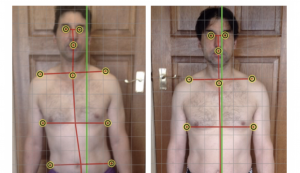
Correcting Lower Back Disc Injuries
Case History: Chronic Lower Back Pain, Disc Herniation and Prolapse
This is not a testimonial. This is a Case Study of a real patient who attended the Practice.
Mr. B. is a 47 year old male factory worker that attended the Practice with acute debilitating lower back pain and disability. His diagnosis was that of lower back disc injuries (L3, L4 and L5). He was suffering chronic spinal pains, mid back and lower back pain with associated myofascial (muscle) weakness in the lumbopelvic region.

Comparison of Axial and Flexural Stresses in Lordosis and three Buckled Configurations of the Cervical Spine
PUBLISHED: Clin Biomech (Bristol, Avon). 2001 May;16(4):276-84. PubMed: https://www.ncbi.nlm.nih.gov/pubmed/11358614
AUTHORS: Harrison DE, Harrison DD, Janik TJ, William Jones E, Cailliet R, Normand M.
CONCLUSIONS: The stresses in kyphotic areas are very large and opposite in direction compared to a normal lordosis.
This analysis provides the basis for the formation of osteophytes (Wolff’s Law) on the anterior margins of vertebrae in kyphotic regions of the sagittal cervical curve.
This indicates that any kyphosis is an undesirable configuration in the cervical spine.
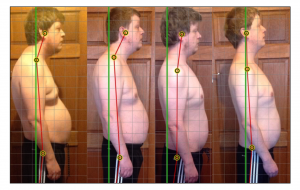
Correcting American Posture
Mr. F. is a 28 year old male garden worker who attended the Practice with what we call ‘American Posture’.
This is a real patient within the Clinic, with untouched photographs.
And yes, he was only 26 when he started care. He was suffering with chronic low back pain (CLBP). He had been enduring spinal pain for 10 years and things were getting progressively worse.
In terms of postural distortion; Mr. F. had what we affectionally call an ‘American Posture’. American Posture is a very common structural disturbance we see in a clinic. And as the name suggests it is very common postural problem within America.
American posture can come in different shapes and sizes. It is a driver of many lower back and neck conditions. As well chronic pain and disability.




